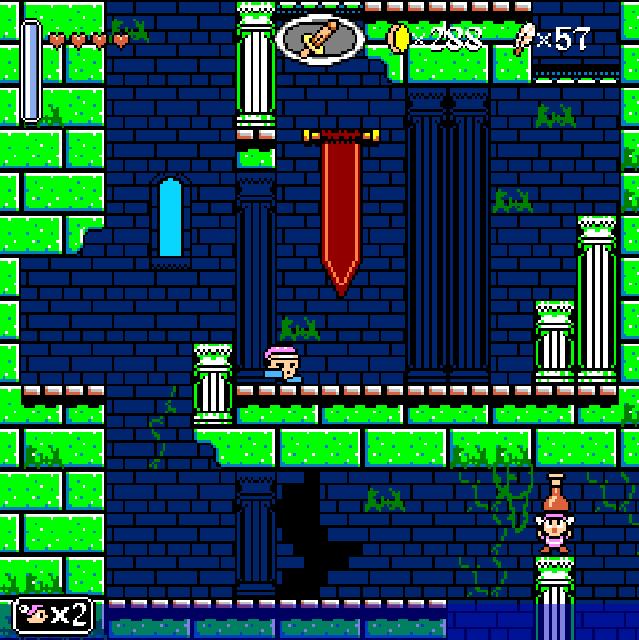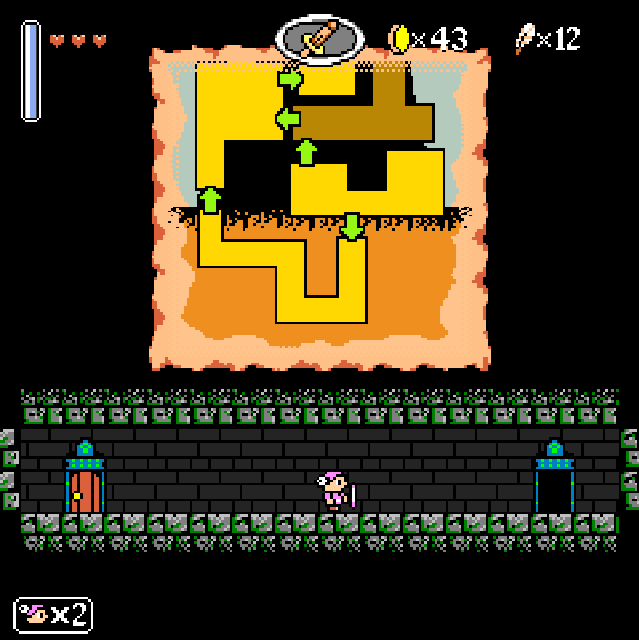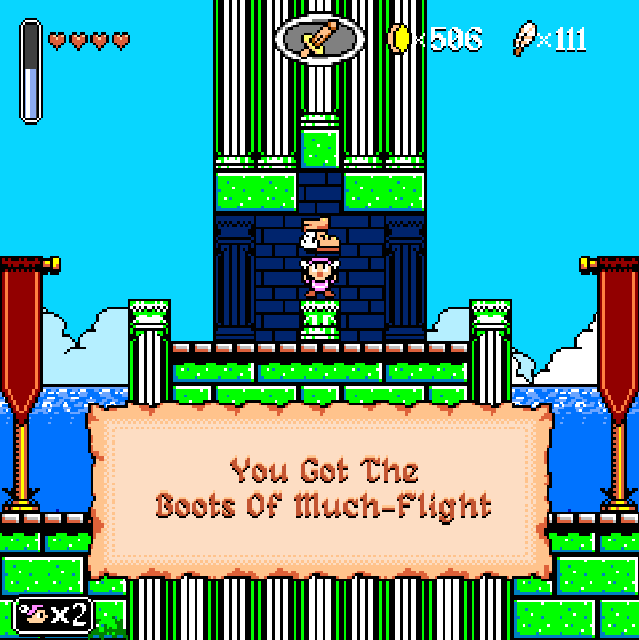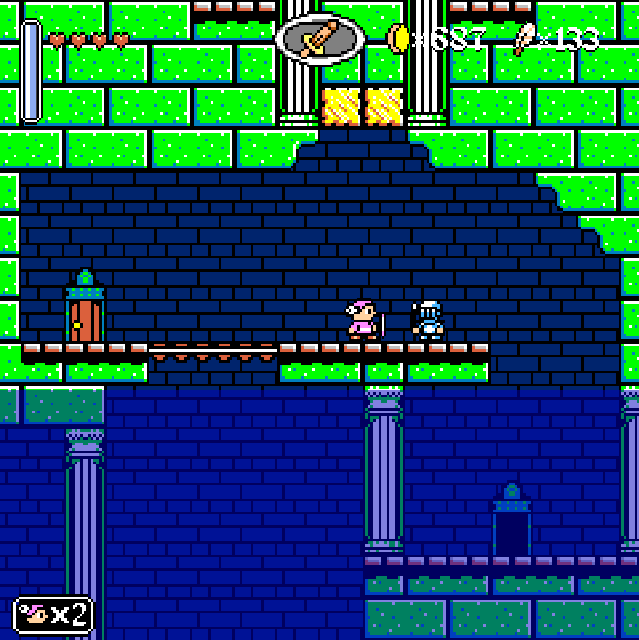Adventure in the Tower of Flight may take some inspiration from Mighty Bomb Jack, but this is far more refined and enjoyable product. Taking on the role of Wing, players must slash and dash their way through the labyrinthine corridors of a legendary tower as they seek out secret treasures with the aid of the power of flight.
Though I compared this game to Mighty Bomb Jack, there are several important differences between the two, the most significant of which is the way jumping is handled. While Jack has a single, very high jump and the ability to slow his descent and hover, Wing’s ‘jump’ consists of flying around. You can either hold down the jump button to continuously fly upward or press it continuously to perform small hops in the air. Flying upward or performing aerial hops drains a flight meter so there is a limit to just how high Wing can actually go. However, the flight meter refills quickly enough that Wing has virtually unlimited horizontal movement while in the air as any meter drained from performing a hop will be refilled by the time Wing reaches the end of his arc. Thus, more vertically-oriented rooms tend to revolve around finding safe platforms to land on from which you can reach higher platforms and horizontally-aligned challenges generally consist of avoiding hazards and fighting off enemies while flying across large pits and dangerous terrain. Overall, this is a great mechanic which allows for some very unique challenges and platforming puzzles.

The general flow of the gameplay here is a pleasant mixture of arcade-style gameplay with some RPG elements and newer concepts added in. Wing is not defenseless as he is armed with a close-range sword which he can use to slash away at enemies in front of him or slightly below him. This sword is useful for more than combat though as it can also be used to open treasure chests and destroy breakable walls. Secrets are plentiful and destructible walls are everywhere, so it’s worth it to try hacking away at any part of the environment which looks suspicious. Some secrets give no more of a hint of their existence than the average Castlevania wall-chicken, but particularly valuable secrets, such as doors hidden behind walls, are hinted at by cracks or other environmental clues and more often than not the actual prize is visible from the start with the real challenge being in figuring out where the twisting hidden path leading to it begins. The extremely common presence of secrets adds a nice sense of exploration to even the most seemingly linear of rooms while the fact that optional doors or items of significant value are always visible to at least some degree allows you to progress through the game without fear of missing one of the more useful collectibles just because you didn’t slash at every unmarked wall.

As much as I love the constant presence of secrets, the actual benefits of finding most of them aren’t all that exciting. There are four pieces of a medallion to find which, if collected, grant access to an optional area (though I have yet to personally collect all four), several health vials which each increase Wing’s maximum health by one point, and one other unique item to find (which is currently glitchy and does not work properly), but that’s it as far as substantial secrets go. Otherwise, secrets either come in the form of healing hearts, feathers, or gems. Gems and feathers are both a type of currency for use in shops, but the extent of what they can be used for is rather limited. Gems can be used to instantly refill your health or to buy a health vial (after you buy the health vial the shop will instead sell extra lives for the same price) while the more rare feathers can be used to buy an item which grants a few seconds of invincibility immediately after leaving the shop and revival potions which will immediately restore Wing’s health back up to full if it runs out. All of these items can be useful on the higher difficulties where enemies hit harder and random healing items drop less frequently, but by the time I reached the final area on Normal I had stopped caring all that much about hunting down secrets because I was already sitting on several extra lives, a few revival potions, thousands of unspent gems, and hundreds of feathers. Add in the fact that backtracking to a previous room results in all of the gems, feathers, and hearts you’ve already collected respawning and the excitement gained from finding a hidden path to a few dozen gems definitely fades away as you enter the later parts of the game. There was an announcement by the developer that new weapons would be added to shops to make the reward for collecting gems and feathers more interesting (in addition to fixing the bug with that one unique item), but that announcement was also made over half a year ago and it is completely unclear as to if this useful addition will ever actually get patched in.

Exploring the tower is straightforward in some ways and more complicated in others. The tower is divided into regions which for all intents and purposes can be treated as different levels as you can’t go back to previous ones; there is an optional region containing a medallion fragment which you can miss in the second half of the game and you get to choose between two entirely different regions after the first one, but regional progression is otherwise linear. Each region is divided into a series of rooms connected by doors; you can see a map of the general layout of each region while travelling between them, though it’s only somewhat useful because doors are in the background rather than attached to walls, which doesn’t translate well to a two-dimensional map. The trick here is that doors close once you enter them, making it difficult to backtrack. In the earlier parts of the game there are several rooms which contain two doors to choose between, one of which will simply take you to the next mandatory room while the other will lead to an optional room which in turn leads to the same room as the first door. Though all doors look alike, there is almost never any real danger of confusing an optional path for the more direct path as the optional door usually takes far more work to reach; a more tangible indicator, such as in the design of the doors themselves, would have been handy as there are a few times where it really is unclear as to just which path is which, but this issue crops up so infrequently that it isn’t actually much of a concern. Later parts of the game become more complicated and begin to allow for a small degree of backtracking with the introduction of locked gates which require you to find a path leading to a key you must bring back to the gate in order to progress. A few neat sequences are also created by the way rooms interconnect, such as in one region where one room is filled with fire and another is filled with ice and you must go through a series of doors to weave your way back and forth between these rooms. Adventure in the Tower of Flight is surprisingly difficult to classify as it isn’t quite nonlinear enough to be a full-fledged Metroidvania, but it’s still a far cry from being completely linear either, the result being a pleasantly interesting experience which is fairly straightforward while allowing for a healthy degree of exploration.

Wing gains access to five permanent upgrades over the course of the game, three of which change up the gameplay quite a bit. The most important of these, the dash, is obtained near the end of the very first region. By holding down a direction and then pressing the dash button, Wing will perform a fast dash in a straight line at the cost of half of the flight meter. This dash can be used both from in the air and from on the ground and it has quite a few uses. In terms of exploration, there are certain blocks which can only be destroyed by dashing into them and it is the only way to open paths above Wing as he is not capable of attacking upward with his sword. In combat, the dash provides some invincibility frames and its speed and precision make it into a useful way to dodge incoming attacks, but it also has offensive value because dashing into an enemy will deal twice as much damage as a sword swing and most enemies hit by a dash will be sent flying backwards in the process. The dash is a fantastic addition to Wing’s arsenal in just about every way as it results in a faster pace, leads to the inclusion of tougher enemy types, and allows for the addition of platforming puzzles where players must make their way to a location while conserving enough meter energy to open the way by performing a dash. The other two important upgrades are a stronger sword and a bow. The stronger sword provides a useful attack power boost, but it also unlocks a charged slash attack which is a valuable asset in combat and is necessary for circumventing the armor of certain enemy types. The bow doesn’t result in quite as dramatic of a change in gameplay as the dash, but it’s a reasonably close second. You can swap between the bow and the sword on the fly and the charged slash can be used even while the bow is equipped, but arrows allow players to experiment with a very different playstyle where damage is sacrificed for range. The bow also allows for a nice bump up in difficulty once it is acquired as dangerous enemies with ranged attacks become far more common; both the sword and the bow’s arrows can deflect projectiles, but many of the challenges thrown at you later on would be at least somewhat unreasonable without the presence of a ranged weapon of your own.

The only area where I think Adventure in the Tower of Flight falls somewhat short other than in its shop inventory is its boss fights. Bosses are big, imposing, and look cool, but there’s just not much to them. Without exception, every boss in the game has a simplistic movement pattern and an even simpler attack pattern consisting of one or two attacks. The closest a fight ever comes to changing things up is in a fight with a lightning-based boss where the boss changes its attack to consist of a greater number of lightning bolts which come down at a faster speed when it is low on health. The simplistic nature of these fights is especially noticeable because the bosses themselves tend to have a high amount of health and the last few bosses require you to stick to spamming dash attacks and/or charged slashes to kill them in anything resembling a reasonable amount of time. Bosses hit remarkably hard and even on Normal most of them are capable of killing Wing in two or three hits even if you’ve been vigilantly collecting health upgrades, but the high damage from boss attacks doesn’t make up for the overall repetitive and overly simplistic nature of the fights themselves. Bosses are a pretty small part of the overall experience so this is by no means a deal breaker, but I do wish these fights were more engaging experiences.

Boss fights and shop limitations aside, Adventure in the Tower of Flight is a fantastic game which captures both the look and feel of retro games while enhancing the experience with a few more modern touches. With great pacing, engaging gameplay, and plenty of secrets, this is definitely a game well worth having for any platformer fans.